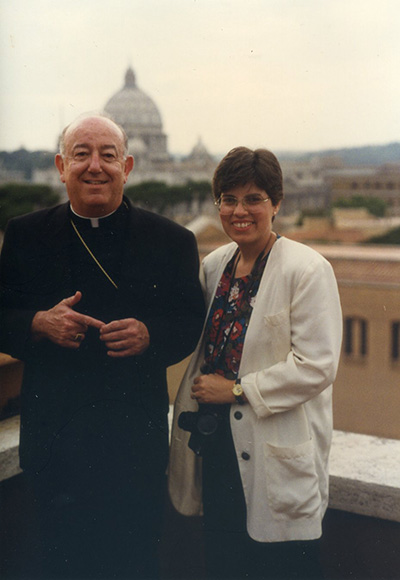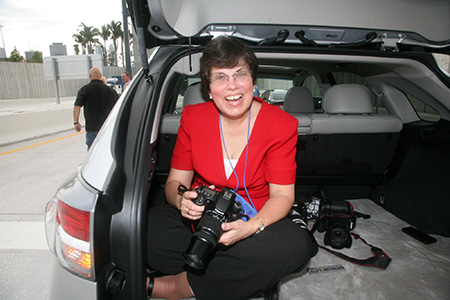Monday, February 26, 2024
Ana Rodriguez Soto
Back
in the summer of 1979, a year before my college graduation, I got my first
professional job in journalism. I was hired as a summer intern, to serve as interim
editor of La Voz Católica.
That
meant filling four pages of news every week, reporting, writing, and editing in
Spanish. My first thought: I can do this! (I had been a reporter and editor for
my high school and college papers.)
My
first day on the job, I called my mother to tell her I had reached the pinnacle
of my aspirations: I had a desk, a phone, a typewriter (yes, an old – even then
– Royal, Google “His Girl Friday” for reference); and to top it all off, I was
getting paid to read and write news.
More
than 40 years later, that feeling of joy and fulfillment has never left me. And
I also never left the archdiocesan newspapers.

Archbishop John C. Favalora and Florida Catholic editor Ana Rodriguez-Soto in Rome after the pallium ceremony for new archbishops, June 1995.
Asked
to return after graduation in 1980 and work for the English-language
publication, then called The Voice, I put in eight years before stepping away to
become a fulltime mom. But I continued to freelance for the newspaper — eventually
renamed the Florida Catholic – returning as a part-timer in 1993 and taking
over as fulltime editor in January 2002.
That’s
over 40 years of covering the “good news” of the Catholic Church in South
Florida: three archbishops, a half dozen auxiliary bishops, more than 100
parishes, over 60 schools, dozens of priests and ordinations, Mother Teresa, Mother
Angelica, all three papal trips to Cuba, a visit to Pope Benedict’s Germany, a
World Youth Day in Poland, a trek to our sister Diocese of Port-de-Paix in
Haiti, two pallium trips to Rome, and yes, even a week in Surfside.
I
have had the privilege of listening to learned theologians, scripture scholars
and liturgists; of interviewing, photographing and interacting with hundreds of
Catholics who bring the faith to life not just in their parishes but throughout
our community. I am convinced I have met countless saints living in our midst.
As
the kids say, it’s been awesome. The job never got old. But I did. I will turn
65 in March and have decided to step away from the deadlines – which are no
longer weekly but now come swiftly, 24/7 – and enjoy the down time that comes
with retirement.

Photographer: TOM TRACY | FC
Ana Rodriguez-Soto in the back of the SUV where she photographed the archbishop’s ride through the new PortMiami Tunnel, August 2014.
I
will miss my work, of course, because I have wanted to be a journalist since
fifth grade. I will miss the camaraderie with colleagues and freelancers, their
creativity and talent, the sheer fun – and constant stress – of our work. I
will miss the unexpected nuggets of praise from our readers that remind us who
we work for.
But
like the stories I have covered over the past 40-plus years, my retirement is mostly
good news. Younger journalists, with different perspectives and new ideas, will
be taking over, helping La Voz and the Miami edition of the Florida Catholic
move forward and keep up with the fast-changing times.
Before
I go, though, I want to correct some mistaken ideas about journalism. First,
that Catholic journalism means covering Masses, and therefore is not “real”
journalism, or simply boring.
As
Gaudium et Spes put it: “The joys and hopes, the grief and anguish of the
people of our time, especially of those who are poor or afflicted, are the joys
and hopes, the grief and anguish of the followers of Christ as well.”
That’s
precisely what Catholic journalists cover: people, their “joys and hopes, grief
and anguish.” That’s never boring. And every person’s story, in the hands of a
good journalist, can illuminate a truth (even if inconvenient) about life,
about human nature, about justice and injustice, about struggles and hope, about
faith itself – in both the Catholic and every other sense of the word.
I
have done my best to focus on those stories throughout my tenure here, something
I learned from my predecessors. I haven’t always succeeded, but I never stopped
trying.
My
second point is that journalism is an education – a constant education for the
journalist, as well as for the readers. For what do journalists do when they
cover a story? They talk to people. They ask questions. They take notes. In a
word, they learn, as much as they can as quickly as they can. Then they turn
around and do their best to share that knowledge with their readers.
Journalists,
then, are both learners and teachers. The old adage is we write the “first
draft” of history. And history is an important subject to learn. Without
history, we have no context for the things we see happening in our world.
That’s
why journalism is important. That’s why newspapers – whether you read them in
print or online – are important. That’s why reading more than the headline is
important.
The
history of the world – and certainly the history of this archdiocese – is
written in volume after volume of printed and online news stories. That’s why
it’s so important to preserve newspapers and to support the work of
journalists, especially local journalists, both in the secular world and in the
Catholic Church.
As
the song asks in the musical Hamilton: “Who lives, who dies, who tells your [Archdiocese
of Miami] story?”
Journalism
has been, for me, a way of providing an education to others while continually
learning myself. It’s been edifying. It’s been satisfying. It’s been a
privilege and an honor to do this work – and to get paid for it!
I plan to
keep rooting from the sidelines for my colleagues in Miami and elsewhere in the
Catholic press. To them and our readers: God bless, and may “good news” be your
story always.
This blog was first published as an article in the February 2024 edition of the Florida Catholic.











